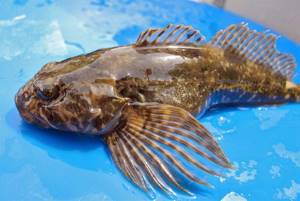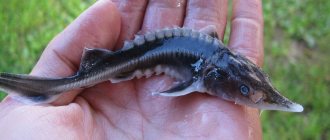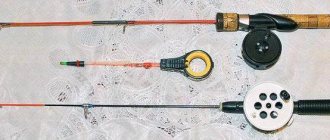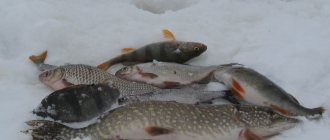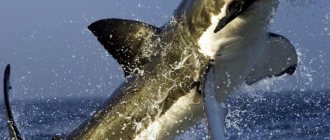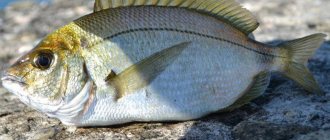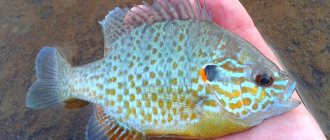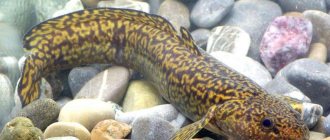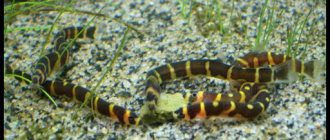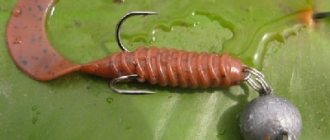- Wild animals
- >>
- Fish
The goby is an amazing fish, so beloved by fishermen of the Azov and Black Seas. Indeed, this is a fairly inexpensive, tasty fish that every tourist appreciates. At the same time, few people know that there are many other different species that are no less popular and interesting for their characteristics.
Origin of the species and description
Photo: Goby
The goby is a ray-finned fish of the perch family. It was first encountered a very long time ago in the Sea of Azov. It is believed that this is where the history of this species of marine life begins. Although exotic species do not arouse any interest among fishermen, the goby is still rather an object of fishing. After all, the Black Sea and Azov gobies are many times larger than the populations of other species. The species of gobies is mainly determined by their habitat and features of appearance.
Video: Goby
Today the following main types of gobies are known:
- sandpiper;
- loudmouth;
- tsutsyk;
- round timber
It is interesting that exotic species are usually not considered when analyzing this category of fish. But all of the above are found in the basin of the Black and Azov Seas. These are common subspecies of gobies, which are usually called ordinary. All of them are objects of fishing. These species have virtually no external differences. The main difference is the size and slight differences in shades.
Interesting fact: In the city of Berdyansk, near the port, there is a monument to the breadwinner bull. This is due to particularly active fishing in this area. Indeed, for many years, local residents mainly survived thanks to this fish.
Kinds
All types of fish are classified in the directory “Fishes of the World”. A fifth edition was published in 2016, edited by Joseph S. Nelson. Systemic relationships in the goby family have been significantly changed. Of all the abundance of species, gobies inhabiting the Ponto-Caspian region can be distinguished. Some of them are commercial species.
- Round goby.
Medium sized bull. Males up to 15 cm, females up to 20 cm. One of the most important species in the Azov Sea from the point of view of commercial fishing. Males often die after the first spawning, at the age of two. Females can spawn several times and live up to five years.
It tolerates salty and fresh water well, so it is found not only in the Black, Azov and Caspian seas. It can rise along the rivers flowing into them up to the central regions of Russia. In this case, it manifests itself as a river goby .
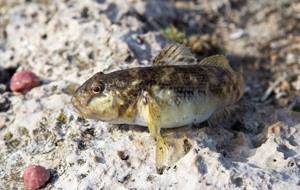
- Sandpiper Goby.
The usual length of this fish is 12 cm. The largest specimens reach 20 cm. Just like the round fish adapted to fresh water. From the Black Sea it spread along the rivers of Ukraine, Belarus and Russia. , rotan and goby fish are found simultaneously . Due to their similar body shape, they are often confused. But fish are distant relatives, coming from different families.
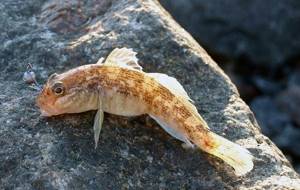
- Shirman bull.
Inhabits the Black Sea estuaries, the Dniester, the lower reaches of the Danube, and the Sea of Azov. It spawns, like other gobies, in the spring. The female lays several thousand eggs. Incubation lasts two weeks. Hatched fry up to 7 mm long. After birth, they lie down on the bottom. After a couple of days, they begin to lead the active life of a predator. They devour all living things that are suitable in size. Mostly plankton. Related species are eaten as food, for example, round gobies.
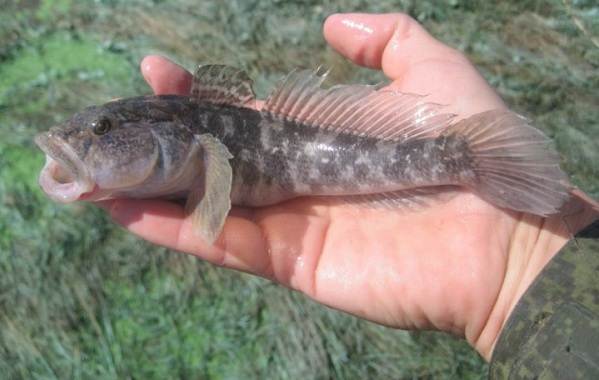
- March goby.
Resident of the Azov and Black Seas. Tolerates water of varying degrees of salinity, including fresh water. Enters rivers. Quite large fish. Up to 35 cm in length and up to 600 g in weight. Predatory. Morals are appropriate: any living creature found at the bottom is eaten. In March, amateur fishermen on the Sea of Azov catch this species more often than other gobies. Hence the name - March.
Along with commercial species, gobies are of interest - residents of marine and reef aquariums. Valenciennea is well known to aquarists. This is goby . Named after the famous French zoologist Achille Valenciennes, who lived in the 19th century. This is a whole family. It includes about 20 species. The most popular four.
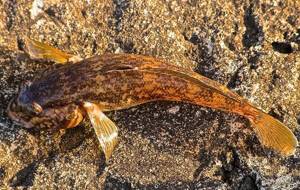
- Golden-headed goby.
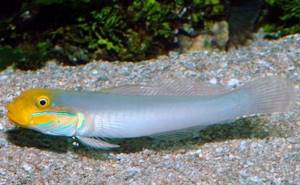
- Red-spotted goby.
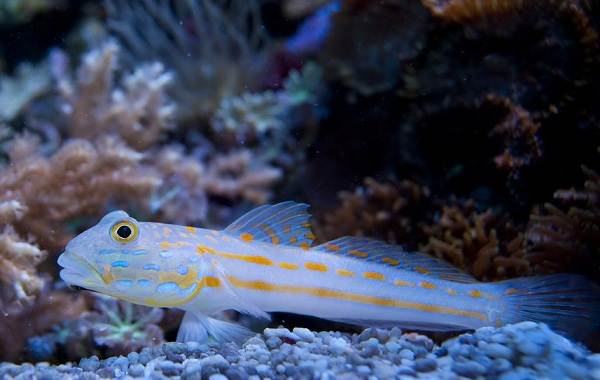
- Pearl valencienne goby.
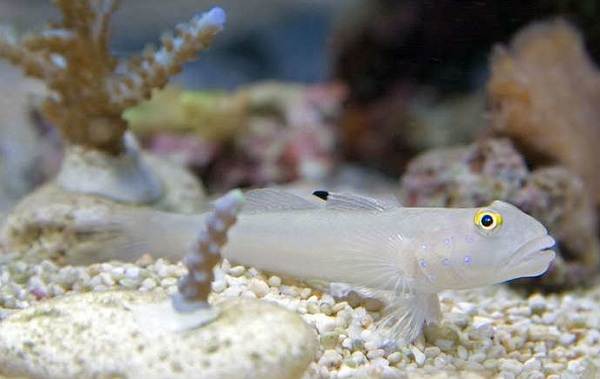
- Two-banded goby.
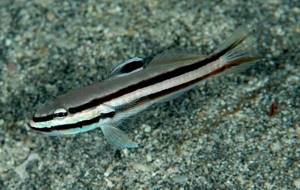
These fish constantly dig in the ground. They are called “burrowing gobies.” They have a simple nutrition strategy. Gobies grab soil with their mouths. Using transverse filter plates located in the mouth, the bottom substrate is sifted. Sand, pebbles, and debris are thrown out through the gills. Anything with a hint of nutritional value is eaten. In addition to their active character, aquarists appreciate their elegant appearance in bulls.
The Rainford goby, or Amblygobius rainfordi, is particularly attractive. This small beautiful fish, the goby in the photo is extremely impressive. It went on general sale only in 1990. As reef aquariums began to grow in popularity. In nature, it does not gather in groups or flocks, prefers loneliness. In an aquarium, it may not get along with its own kind.
The most amazing thing about the Dracula bull is its name. Why Stonogobiops dracula, a resident of the Seychelles and Maldives, received this name is difficult to say. A small striped fish coexists in the same hole with a shrimp. Probably, the simultaneous appearance of a goby and a shrimp from a hole made a strong impression on its discoverer.
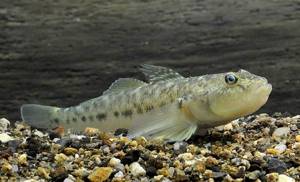
Appearance and features
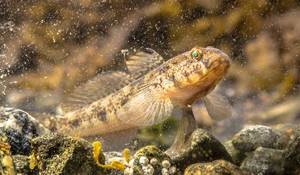
Photo: What a bull looks like
In terms of its external characteristics, the goby is in no way an attractive fish. But at the same time, it has several important distinctive features that help not to confuse it with any other fish:
- From below, the fins grow together in such a way that they form a sucker. With its help, the bull can easily be attached to stones and other surfaces;
- large mouth with large lips;
- the abundance of colors makes it sometimes difficult to recognize, but it is still possible to identify it using the previous parameters.
The goby itself is a little yellowish with dark spots. At the same time, there is now such an abundance of species that it is impossible to universally single out any one color. Depending on the type of fish in question, its parameters also differ. It can be from a few centimeters to half a meter in length. Weight also varies from 30 grams to 1.5 kg.
The Azov goby, familiar to most people, is not particularly large in size, and also has a grayish tint. But exotic species living in bright countries are distinguished by brighter colors. The shades of the fish's fins also differ. They are mostly transparent, but there are all kinds of tints, even reddish. The fins cannot be called too large. But the bull’s head is quite massive for such a body.
Description
goby
The round goby belongs to the Bychkov family, which is represented by more than 20 species in the coastal zone of the Azov and Black Seas, in estuaries, river mouths and the rivers themselves. Length up to 25 cm, weight up to 250 grams. The body is stocky, the tail is flattened towards the end, completely covered with scales, which also extend to the back of the head. It has a ridged head typical for gobies, a brownish-gray body with variations in tones, on the sides of which there are several dark brown elongated spots. It differs from other gobies by the presence of a black oval spot on the first dorsal fin.
The system of canals and pores of the lateral line is well developed, especially on the head. The mouth is of moderate length, its corners do not extend beyond the eyes. The coloring is varied, from light gray with subtle spots on the sides, to brown with a clear pattern or black (the latter is especially common during the spawning period, the males guarding the eggs remain black), however, there is a characteristic species-specific feature of this goby - a clear black spot, sometimes surrounded yellowish border on the back of the first dorsal fin. The head is usually darker than the body, the fins are gray.
Where does the goby live?
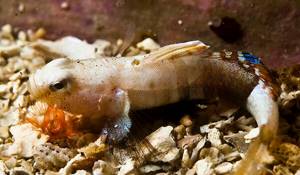
Photo: Goby fish
The goby lives in warm waters. In particularly cold climates, fish cannot survive. The Black and Azov Seas are the main habitats of the goby. The Caspian Sea and the Mediterranean Sea are also his favorite places. The goby is found in smaller numbers in the Baltic. Also, fish can often be found in various estuaries.
In addition, some species of goby prefer fresh water bodies. We are talking about rivers, their tributaries, and lakes. Gobies are mainly found in the basins of the Dnieper, Dniester, Danube, and Volga. Gobies belong to the category of bottom fish. They lead a sedentary lifestyle and prefer to stay as close to the shore as possible at the bottom.
The bull is very leisurely. That is why it is not characterized by seasonal migrations, as well as active movements. Only on the eve of severe frosts does the fish move away from the shore and prefer to stay in the depths.
Gobies especially love to build burrows in the sand at the bottom. They can also wait between stones or in mud - these are their favorite places where they feel most comfortable. Typically, the goby prefers to build a hole that can accommodate 1-2 fish. But sometimes they can live in larger flocks. Depending on the type of goby, they can live in both fresh and sea water.
By the way, many people imagine the goby as a local fish. In fact, they live all over the world. It is difficult to find a place where gobies are not found at all. You can find a lot of exotic bulls. About a third of the representatives of this species live in corals.
Catching
When catching gobies, the fisherman does not need to purchase sophisticated baits and tackle; the simplest, even homemade, devices will do. Any fishing rod will do, both spinning and float. You just need to take a boat to the habitat of these predators. As mentioned earlier, the fish is quite unpretentious and can take root in both sea and river depths. Focus only on the bottom topography.
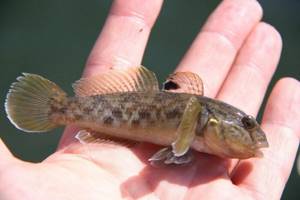
Gobies prefer to swim in the pier area, near steep banks, and in deep holes. In the warm season they come closer to the shore, in cloudy seasons they cluster in the depths. Remember that the bite stops when water bodies bloom. Because plants block the access of oxygen.
It is best to catch gobies in the autumn (September or October), since before the onset of cold weather they begin to actively feed. Experienced fishermen know that early morning before dawn (4-5 am) is the most optimal time for fishing.
What does the bull eat?
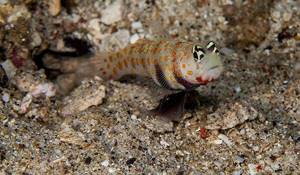
Photo: River goby
The bull is extremely leisurely. This is why he is not very comfortable spending a lot of time hunting for other marine life. At the same time, he also does not strive to collect plant food. The solution for it is bottom dwellers. Among them, he selects those who make a minimum of movements and do not move at high speed.
That is why the basis of the goby’s diet consists of: small larvae, crustaceans, shrimp, worms, mollusks, and some types of fry. The goby tries to find those types of fry that, like himself, do not lead an overly active lifestyle.
The goby is quite voracious and therefore spends quite a lot of time searching for food. He often tries to hide in thickets or behind rocks and then suddenly attack a passing shrimp or any other sea inhabitant. The fish's large mouth allows it to swallow prey completely.
Some people mistakenly believe that the bull is completely unpretentious in food. Indeed, he is not too picky, but at the same time he will not pick up garbage from the bottom. It is much easier for him to completely limit his diet than to actively hunt or eat anything.
Interesting fact: If bad weather is raging, the goby does not go hunting and tries to minimize its food. Instead, he waits out the bad weather in peace and only then returns to his usual way of life.
Fishing for rotan
The herb prefers a shallow coastal zone with a maximum concentration of fry, small crustaceans, amphibians, and bottom larvae, which serve as its food base. In such a situation, catching fish with a classic long-range donka is impractical due to frequent difficult recasts. In open warm water, the best tackle for rotan will be a fly rod.
In spring, autumn and on cloudy summer days, light spinning rods, such as microjigs, prove effective. Also, for quiet and accurate catching of large rotan, a zherlitsa or a bottle donka are suitable. In winter, fish are caught from under the ice using a live bait bait or a nodding rod.
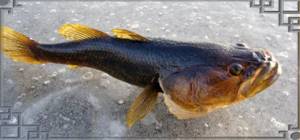
Bait selection
The voracity and omnivorous nature of the species determines a wide selection of baits of animal origin. The predatory rotan fish bites well on:
- crawling, earth and dung worms;
- bloodworms, maggots, caddis flies;
- meat of snails, mollusks, amphibians;
- small bait fish;
- artificial baits.
It is often practiced to catch rotan using chicken meat and skin, pieces of beef and lard, and strips of fresh fish. Such baits allow you to concentrate on catching predators and practically reduce to zero the likelihood of bites from carp species: crucian carp, roach, rudd, etc. In overpopulated reservoirs, rotan can consistently peck on some plant baits (peas, bread, corn, dough).
To learn more:
Peculiarities of rotan biting in October
Fishing with a float rod
Despite the light weight of the fish and moderate resistance when fishing, the tackle for rotan should not be too thin and withstand a tensile load of several kilograms. This is due to the peculiarity of the predator’s habitat, which is replete with aquatic vegetation and bottom debris.
The best option would be a green or brown monofilament line with a thickness of 0.1-0.15 mm. Installing a leash is not necessary, but in order not to tear off the entire equipment when hooked, it is better to arrange a separate installation of the hook using 20-30 cm of thinner fishing line 0.08-0.12 mm.
Particular attention should be paid to the choice of hook for rotan, which should be large in size and with a long shank (No. 4-8 according to the international classification). Otherwise, the angler will constantly be faced with the problem of pulling out a deeply swallowed bait. For the same reason, you should always have a long extractor with you.

The rotan bite is quite specific. He often gently takes the bait with his lips and slowly chews it. At the same time, the swimming trunk trembles slightly, but remains in place. If you don't make a short and sharp hook within 1-2 seconds, the hook will end up deep in the predator's throat and it will be difficult to get it back.
Despite the fact that rotan is a bottom-dwelling fish, it carefully monitors the space above its head and immediately attacks prey swimming nearby. That is why it is advisable to adjust the tackle so that the nozzle is 5-10 cm above the bottom level.
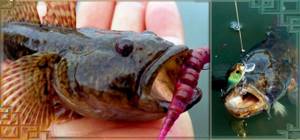
Catching rotan with silicone baits
When using artificial baits (maggots, bloodworms, worms, crustaceans), it is advisable to treat them with an attractant based on animal blood. If this is not possible, just wipe the nozzle with lard (lard) or roll it in a crushed piece of chicken, beef or pork.
Fishing for rotan with a spinning rod requires the use of ultralight rods with minimal testing. In addition to silicone baits and jig heads, you can use micro-spinners and small wobblers, for example Yo-Zuri Snap Beans, Pontoon 21 Cheerful 34 MR. The most catchy for rotan is twitching wiring with short and frequent jerks.
To learn more:
Common loach and Amur loach: lifestyle, spawning and fishing
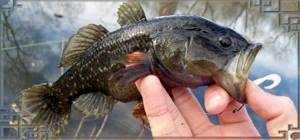
Fishing with a bottle
In modern fishing for predatory fish, the classic “circle” tackle has been successfully replaced by a more accessible and cheaper device made from sealed plastic containers with a volume of 0.5-1.0 liters. At the same time, the operating principle and installation diagram of a bottle donk are not much different from the original. The modernized tackle also has a reeled supply of fishing line, a sinker (sliding or blind), a leash with a hook on which live bait is located.
In the loaded position, the plastic bottle floats vertically and is 2/3 hidden under water due to the tension of the sinker. At the moment of a bite, the rotan pulls the fishing line and pulls it out from under the rubber band, which serves as a stop-limiter. This leads to a weakening of the tension and the bottle floating up in a horizontal position, which is a signal for the fish to bite.
The reverse scheme can also be used, when the bottle from a horizontal one takes a vertical position at the moment the rotan winds the entire supply of fishing line.
Features of character and lifestyle
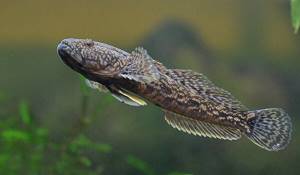
Photo: Sea goby
The goby is not a particularly active fish. He prefers to lead a sedentary, sedentary lifestyle. Active migrations are not for him. Also, the goby cannot be called a schooling fish. He prefers to live in small families. At the same time, even for spawning, the goby prefers not to go far, but to stick to its usual habitat, simply preparing the necessary place for this in advance, equipping a kind of house for spawning.
But there are still certain exceptions to the rules. Depending on the species, the goby may not approach the shores at all and even spawn in deep water. But other species that live in waters that are too fresh or salty may come to the shore to spawn or even enter river mouths.
In any case, it’s not often when the bull is ready to move. He prefers not to move long distances, much less often. He also does not go hunting too actively, preferring to wait for prey in ambush rather than pursue it. This is why bulls often have certain difficulties in this matter.
Also, the goby is not particularly friendly towards other fish, preferring to lead a solitary lifestyle. The maximum he is ready for is to live together with representatives of his own species, and then in small quantities, not all the time.
Interesting fact: Goby hates temperature changes. In this case, he can easily fall into torpor, stop not only hunting and eating, but even moving altogether.
Striped shrimp goby
These gobies are also called threadfin red-striped gobies. In nature, they live among the reefs of the Indian and Pacific Oceans. The body length of shrimp gobies does not exceed 4-5 centimeters. These fish live together with click shrimp. Shrimps provide fish with housing by digging a burrow; they get along well in the burrow. The shrimp benefits from such a neighborhood, since the fish thanks the hostess for her hospitality, warning her about the danger. If an enemy approaches, the goby pushes the shrimp, which has difficulty seeing, towards the hole with its tail.
In captivity, these gobies can live without shrimp. They get along well with other gobies, but the aquarium should not be cramped.
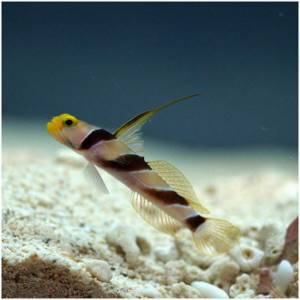
To catch gobies, they use the local method - under the boat, near the pier, etc., or they catch it “by stretch”.
Social structure and reproduction
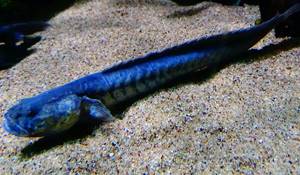
Photo: Blue bull
The goby begins to spawn in the spring. In March, a long period of spawning begins. It is enough for the temperature to rise to 10 degrees. After that, spawning will last until the very end of summer. Males are considered sexually mature in the second year of life. During spawning, they immediately change their color to a much darker one. After this, the male hides among the stones and begins to wait for the female, who will go to spawn.
If several bulls claim this place at once, then they may well start real fights for territory. The winner remains to equip a kind of nest, where the females are then lured. One male can attract several females at once. Depending on the type in question, the female can lay up to 7,000 eggs at a time.
The caviar has a slightly sticky shell, with which it is securely attached to the stones. It is interesting that immediately after spawning the female can go about her business, while the male will guard his offspring for another month. Otherwise, there is a high risk of eggs being consumed by bottom invertebrates. Males have a hard time protecting their eggs from being eaten, but they also take care of comfortable conditions for their offspring. To provide the oxygen necessary for the eggs, they create intense flows of water with their fins, which brings oxygen.
A month later, fry immediately appear from the larvae that emerge from the eggs. Bottom crustaceans are the main diet of babies during this period of time. But not for long at all. By the end of summer, gobies will be able to eat like any other adult fish. By the way, at this time the bulls are considered very noisy. To attract a female to his burrow, the male makes sounds similar to growling or slurping.
Reproduction
Sexual maturity of rotan occurs at 2-3 years. Spawning occurs in April-May at a water temperature of +15-18°C. Shallow water with dense vegetation or an abundance of hard substrate is chosen as a spawning ground, on which female rotan lay a portion of several even rows of elongated and sticky eggs with a diameter of 1.3-1.5 mm. The pause between clutches is 2-3 weeks. In one season, each female is capable of giving birth to 800-1000 fry.
During the breeding season, males acquire a nuptial black color, which is why the species received the nickname “firebrand.” Immediately after spawning, they take full care of the future offspring, guarding the clutch around the clock and fanning it with fins to enrich it with oxygen. The rotan larvae remain completely safe, as they hatch from the eggs in 4-5 days and immediately begin feeding on zooplankton. At the same time, the grown fry can already become dinner for its parent, so it reliably hides in dense vegetation away from its relatives and other fish.
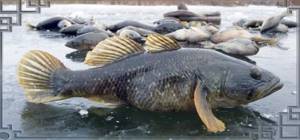
Natural enemies of the goby
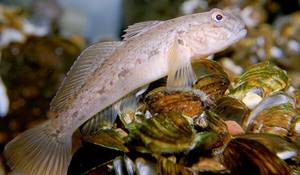
Photo: Goby fish
The goby is very vulnerable to predatory fish. The main reason is that the fish is very slow and clumsy. If other species, having no protection from the enemy, have every chance of fleeing, then such an option is excluded here. The goby swims extremely slowly, so it will not be able to escape.
Its only advantage is its color. The goby is very unremarkable in appearance (the majority of species) and has no difficulty in merging with the ground or stone. Pike perch, stellate sturgeon, sturgeon - this is a far from complete list of those predators that love to feast on bulls. Also, the Azov dolphin does not refuse to eat gobies.
But the most interesting thing is that some species make a living by eating the fry of other gobies. But it’s not only in the reservoir itself that danger lurks for the goby. Like many other fish, the goby often suffers from attacks by birds. Herons actively hunt various types of gobies. Even snakes are ready to compete with herons.
At the same time, many still agree that people remain the most dangerous for bulls. They are the ones who contribute to a greater extent to the reduction of goby populations. They catch gobies in every possible way imaginable. Weather conditions can also become dangerous for the goby, since these fish are very sensitive to them.
Green-striped goby
In their natural environment, these gobies live in Puerto Rico. Green-striped gobies have a dark green color, and white transverse lines run along the body. There is a wide black stripe across the eyes.
These bulls are unpretentious in keeping, they have a peaceful character. They reproduce easily in an aquarium and lay their eggs between stones.
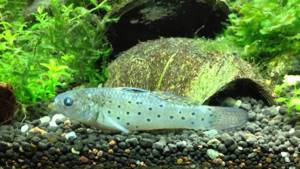
There are freshwater species of gobies that can be kept in an aquarium.
Population and species status
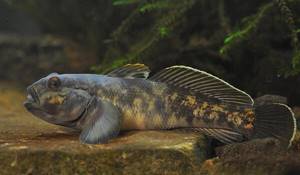
Photo: What a bull looks like
Objectively assessing the goby population can be quite challenging. The main reason is that today too many species of this fish are known. That is why it is quite difficult to say in general how the population is assessed. In addition, gobies are distributed throughout the world, so it is impossible to estimate their number even approximately.
Tracking the goby population is quite a serious and important task. The reason is the increased industrial importance of this category of fish. This is why it is so important to monitor how much the population is declining. It is not possible to assess the entire population. The goby has a rather short life cycle. Against this background, the number of gobies can be called approximately wavy. Sometimes the change in quantity can reach hundreds of times.
Although today there are quite a lot of gobies in Azov, their catch is strictly controlled at the state level. For example, every year when fish go to spawn, it is prohibited to catch it. Also at this time it is prohibited to drill the bottom or carry out any work dangerous to fish. Although the Azov and Black Sea gobies officially belong to the category of fish that do not need protection. But some species of exotic fish are so rare that special government programs are being developed to protect them.
Goby fishing
Few species of these fish are commercial targets. But goby populations indirectly affect commercial fishing results. Goby is a fish that is included in the diet of other marine life: cod, sea bass, flounder.
Catching gobies is one of the traditional activities of the Black Sea and Azov amateur fishermen. It is also popular among fishermen living in the Caspian Sea. The tackle is simple. Usually this is a float rod or donka.
The main thing is that the bait lies freely on the ground. Pieces of fish flesh, worms, and maggots can be used as bait. Successful fishing, especially at first, is only possible after consulting with a local expert.
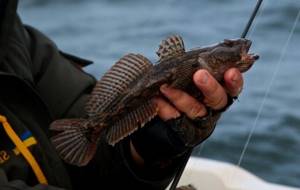
Industrial fishing is carried out using drag nets and fixed nets. The usual method for catching predatory, bottom-dwelling fish is hook tackle such as a seine. The volume of industrial production of goby in Russia is insignificant and is not included in the statistical indicators of Rosrybolovstvo.
Tropical species have taken part in the fishing business in a different way: they have become regulars in home aquariums. So popular that they are caught, raised and sold on an industrial scale.
Useful properties of bulls
General benefit
This fish has many beneficial properties, so it must be included in the diet. In some cases, doctors recommend eating bulls if it is necessary to restore health. The rich composition of this product allows it to be used as a source of valuable vitamins, minerals, proteins and fatty acids. There are universal properties in bulls that are useful to all people, regardless of age, gender, or body condition.
- Fish is very beneficial for people with heart disease. Magnesium and the fatty acids it contains strengthen the heart muscle, normalize the vascular system and improve blood flow to tissues.
- The ingredients in the product help the body process excess cholesterol, which is harmful to blood vessels and can cause serious complications.
- The nutrients contained in gobies improve brain function. The fatty acids of this fish improve memory, increase intelligence and concentration. In addition, proteins from this product are involved in neurogenesis, that is, they are used to create new brain cells.
- The fatty acids contained in fish, in particular omega-6, improve the appearance of the skin, strengthen the hair, make it silky and shiny.
- Bulls contain vitamins that have antioxidant effects. They protect against various types of cancer. According to recent research, omega-3 also prevents the growth and development of cancer cells.
- For those who are in a state of apathy and depression, eating this fish can be very beneficial. The active components of the product normalize the synthesis of hormones responsible for vital energy, emotional and mental health.
- Bulls are an excellent product for those who suffer from hypertension. The product does not contain trans fats, and omega-3 and omega-6 help increase the lumen of blood vessels. Magnesium prevents seizures, relieves spasms and reduces cortisol levels in the blood.
As you can see, when consumed regularly, bulls can significantly improve health and even help cope with various diagnoses. It is also worth considering the benefits of this product for women in different physiological conditions, men and children.
For women
Deficiency of calcium and sulfur in a woman’s body has a very negative effect on reproductive function, so bull calves are a healthy food for those who are planning to become pregnant. This product protects the body from mineral deficiency. The fatty acids contained in fish provide reliable protection against infectious diseases and support the immune system. Omega-3 also helps prevent breast and cervical cancer when consuming fat-soluble vitamins (tocopherol and retinol).
For men
It is very beneficial for men to eat this fish for three reasons.
- Proteins are essential for the proper functioning of the reproductive system.
- Antioxidants protect against inflammatory processes and cancer, to which strong people over 40 years of age are predisposed.
- Fatty acids and mineral compounds support vascular and heart health, reducing the risk of stroke and heart attack.
According to statistics, men are predisposed to certain endocrine diseases associated with deficiency of iodine and other minerals, so consuming fish is a good preventive measure for them. In bulls, 18% of proteins are easily absorbed by the body and are used to maintain muscle health. This is an indispensable product for men who lead an active lifestyle, are exposed to high physical activity every day or are keen on strength training.
During pregnancy
Doctors and many people far from this profession like to repeat: “Pregnancy is not a disease.” This is true, but this is a natural state for the body, which is quite tiring. Women aged 38-40 weeks can develop a number of problems and diseases if they do not provide their bodies with the full range of substances necessary not only for the development of the child, but also for the health of his mother. Bulls are a very valuable product for women expecting a child, as it helps avoid shortages of essential substances to maintain health. Here are just a few beneficial properties of this fish that are important during pregnancy:
- strengthening teeth, bones, normal formation of the baby’s skeleton due to the content of calcium and vitamin D.
- Maintaining immunity, protecting against infectious diseases that are quite difficult to cure due to the impossibility of using traditional medications during this period.
- Supply of substances necessary for the development of the nervous system of the embryo.
- Protection against depressive disorders, maintaining normal hormonal levels.
- Preventing excessive weight gain due to low calorie intake.
- Protection against anemia in pregnant women and fetal hypoxia.
- Strengthening the cardiovascular system of children and women.
As you can see, there are many benefits of eating bulls. The most important thing is to avoid using dried or stockfish in your diet due to the risk of toxic foodborne infections, as well as the high amount of salt that can lead to swelling.
While breastfeeding
Regular consumption of calves during breastfeeding helps women cope with stress and fatigue, and speeds up the recovery process after childbirth. If a woman ate fish regularly before giving birth, there is no need to limit her consumption of this product after giving birth. If there are no contraindications, bulls will be useful not only for the mother but also for her child.
Bulls are a valuable food for lactating women, as they contain essential ingredients for breastfeeding and also replenish minerals and vitamins, which has a positive effect on the health of the mother and the development of the child. Very rarely, children are allergic to this product, only in this case it is worth excluding it from the diet.
Women during this period urgently need digestible protein, and bulls contain a lot of protein. In addition, they contain fats and fatty acids, which are necessary for the child's growth, immunity and proper development of the nervous system. These components are also involved in the regulation of metabolic processes and the synthesis of hormones necessary for the functioning of the body.
Iodine, selenium, magnesium, phosphorus, sulfur and calcium are components that breastfeeding mothers usually lack and their babies suffer from it. Healthy development of bones, teeth and the cardiovascular system depends on these substances. Bulls fully satisfy the needs of the female body for these microelements, and also, when consumed regularly, prevent mineral deficiency in the child.
This type of fish is a source of B vitamins. Riboflavin, pyridoxine, cyanocobolamin, pantothenic acid are substances that mothers and children need for hematopoiesis, immunity, healthy skin and hair, and also support the nervous system.
For children
Children can also eat oxen from the age of three. A child grows rapidly from birth, and animal protein is necessary to support these processes. 100 g of bulls contains 18 g of protein, which practically covers the daily requirement of a preschooler for this ingredient.
In addition, fish contains fatty acids that are necessary for the child’s body. It gives the following effects:
- stimulates the brain;
- improves memory;
- increases concentration, which is very important for effective learning;
- takes care of skin health, protects against dermatitis;
- improves the functioning of the digestive and cardiovascular systems;
- they protect the liver from toxins.
B vitamins, consumed in combination with fats contained in fish, provide reliable protection against infections and help the child’s body cope with colds and other diseases more quickly. Mineral compounds ensure bone growth, harmonious development of the skeleton, and protect the nervous system.
Lifestyle
In addition to the fact that rotan is an active and quite dangerous predatory fish, it is characterized by cannibalism. The diet of firebrands consists not only of fry and eggs of other representatives of the ichthyofauna, but also of their own relatives. Adult fish eat almost everything that moves - even leeches and tadpoles. The fry menu includes plankton and zoobenthos.
Look - Perch fish: environment and habitats, size, spawning, nutrition and characteristics of the species (90 photos)
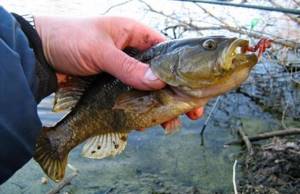
Despite the small size of rotan fish, its appetite is terrifying. She does not know a sense of proportion, so she can cause the disappearance of other species of fish in a single pond. It is not for nothing that the firebrand is considered a trash fish, and the reservoirs in which it swims are considered biologically polluted.
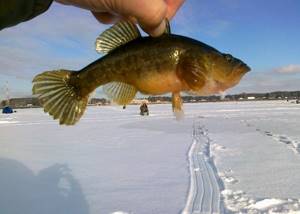
Rotan is also food for larger predatory fish, such as pike and perch. Fishing for it is quite an interesting event, especially if it happens in winter.
Rotan
Rotan is the only representative of the firebrand genus; there is simply no other fish like it in Europe.
The homeland of rotan is the Amur River basin, the Russian Far East, northern North Korea and northeastern China. Amur sleeper was brought to Central Europe as an aquarium fish, since it is a very interesting object for observation. How it got from aquariums to water bodies can only be guessed at. Apparently, one of the aquarists simply released their rotans into the nearest pond, maybe they were just tired of them, or maybe they wanted to breed this fish in their home pond.
Rotan is able to live in heavily polluted water and tolerates a lack of oxygen well, this contributed to its distribution in reservoirs where winter death is frequent, and other fish have practically no chance of surviving there... In the literature they write that it is able to survive even when completely frozen, and after defrosting continues to live its own life. I didn’t conduct such experiments on them, but one day I found a rotan in my backpack in the morning, forgotten there since the evening. The poor fellow spent the night in a closed compartment of the backpack, covered in various garbage, but as soon as I put him in a jar of water, he immediately came to life. I consider the stories that rotan destroys the eggs and juveniles of other fish in a reservoir, which is why it becomes its absolute owner, to be greatly exaggerated. In at least one of the rivers near Moscow where it is found, there is a varied amount of other fish: perch, bream, roach, pike, pike perch, catfish, ide, chub... Amur sleeper did not compete with any of them as food, and did not eat up all the eggs .
The reason for this misconception, in my opinion, is quite understandable. Since, as I already mentioned, rotan survives in overseas reservoirs, it is not surprising that, often, no one is found there except it. In the ponds of Moscow and the Moscow region, along with rotan, two other species of fish that are equally resistant to lack of oxygen - crucian carp and verkhovka - feel quite well, and sometimes in huge quantities. It would be ridiculous to assume that this happens because rotan does not eat the eggs of these fish.
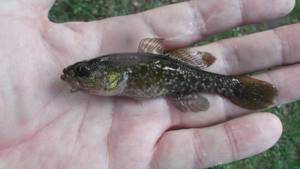
Rotan
Goby fish. Description
The fish got its name because of its large head, disproportionate to its body. You can see what a goby fish looks like in the photo below. The eyes are located on the top of the head close to each other. The oblong body reaches a length of forty centimeters. There are two spiny fins along the back. On the belly, the fused fins have transformed into a sucker, allowing them to attach to stones. Thanks to the suction cup, even strong waves are not dangerous for the gobies.
